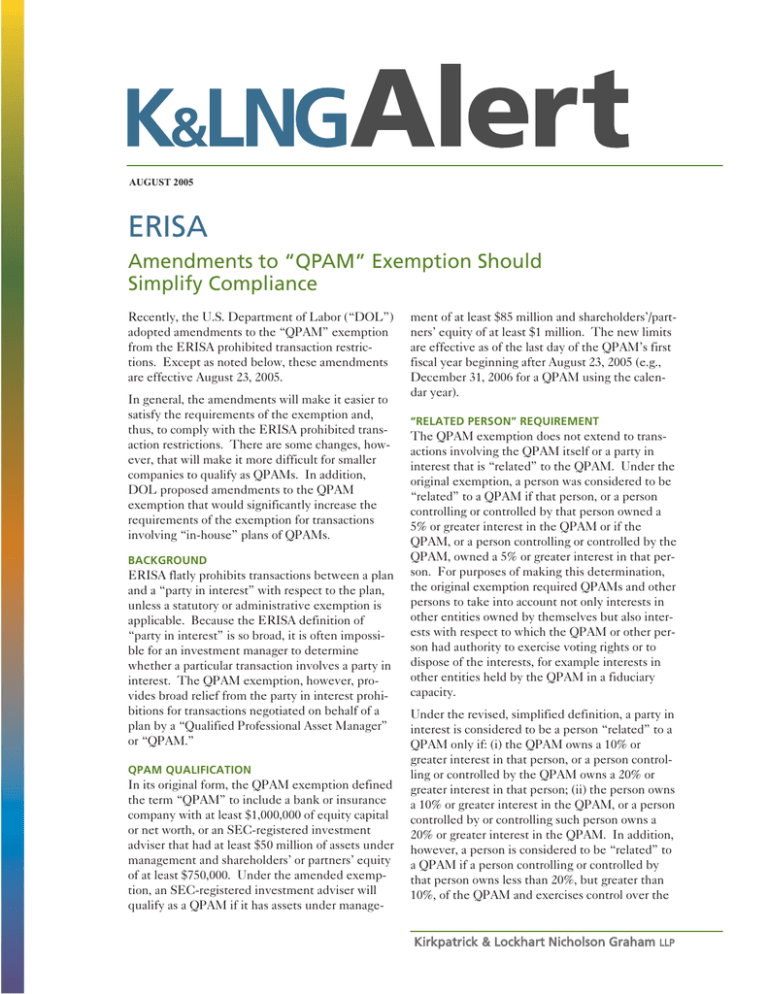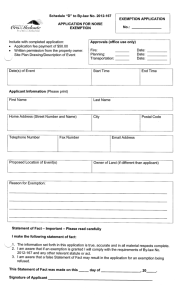
AUGUST 2005
ERISA
Amendments to “QPAM” Exemption Should
Simplify Compliance
Recently, the U.S. Department of Labor (“DOL”)
adopted amendments to the “QPAM” exemption
from the ERISA prohibited transaction restrictions. Except as noted below, these amendments
are effective August 23, 2005.
In general, the amendments will make it easier to
satisfy the requirements of the exemption and,
thus, to comply with the ERISA prohibited transaction restrictions. There are some changes, however, that will make it more difficult for smaller
companies to qualify as QPAMs. In addition,
DOL proposed amendments to the QPAM
exemption that would significantly increase the
requirements of the exemption for transactions
involving “in-house” plans of QPAMs.
BACKGROUND
ERISA flatly prohibits transactions between a plan
and a “party in interest” with respect to the plan,
unless a statutory or administrative exemption is
applicable. Because the ERISA definition of
“party in interest” is so broad, it is often impossible for an investment manager to determine
whether a particular transaction involves a party in
interest. The QPAM exemption, however, provides broad relief from the party in interest prohibitions for transactions negotiated on behalf of a
plan by a “Qualified Professional Asset Manager”
or “QPAM.”
QPAM QUALIFICATION
In its original form, the QPAM exemption defined
the term “QPAM” to include a bank or insurance
company with at least $1,000,000 of equity capital
or net worth, or an SEC-registered investment
adviser that had at least $50 million of assets under
management and shareholders’ or partners’ equity
of at least $750,000. Under the amended exemption, an SEC-registered investment adviser will
qualify as a QPAM if it has assets under manage-
ment of at least $85 million and shareholders’/partners’ equity of at least $1 million. The new limits
are effective as of the last day of the QPAM’s first
fiscal year beginning after August 23, 2005 (e.g.,
December 31, 2006 for a QPAM using the calendar year).
“RELATED PERSON” REQUIREMENT
The QPAM exemption does not extend to transactions involving the QPAM itself or a party in
interest that is “related” to the QPAM. Under the
original exemption, a person was considered to be
“related” to a QPAM if that person, or a person
controlling or controlled by that person owned a
5% or greater interest in the QPAM or if the
QPAM, or a person controlling or controlled by the
QPAM, owned a 5% or greater interest in that person. For purposes of making this determination,
the original exemption required QPAMs and other
persons to take into account not only interests in
other entities owned by themselves but also interests with respect to which the QPAM or other person had authority to exercise voting rights or to
dispose of the interests, for example interests in
other entities held by the QPAM in a fiduciary
capacity.
Under the revised, simplified definition, a party in
interest is considered to be a person “related” to a
QPAM only if: (i) the QPAM owns a 10% or
greater interest in that person, or a person controlling or controlled by the QPAM owns a 20% or
greater interest in that person; (ii) the person owns
a 10% or greater interest in the QPAM, or a person
controlled by or controlling such person owns a
20% or greater interest in the QPAM. In addition,
however, a person is considered to be “related” to
a QPAM if a person controlling or controlled by
that person owns less than 20%, but greater than
10%, of the QPAM and exercises control over the
Kirkpatrick & Lockhart Nicholson Graham
LLP
management policies of the QPAM by reason of
its ownership interest. Also, a QPAM is “related”
to a person if a person controlling or controlled by
the QPAM has a less than 20%, but greater than
10%, ownership interest in that person, and such
controlling or controlled person exercises control
over the management policies of such person by
reason of its ownership interest.
Finally, the amended exemption permits financial
institutions to disregard securities held in a fiduciary capacity for purposes of determining whether
that person is related to a QPAM.
“HIRE OR FIRE” REQUIREMENT
Prior to the amendments, the QPAM exemption
did not extend to transactions involving a party in
interest if the party in interest or its affiliate had
the authority, or within the last year exercised the
authority, to hire or fire the QPAM as investment
manager for the plan’s assets.
One of the amendments to the QPAM exemption
eliminates the one-year “look back” aspect of the
requirement. In addition, the amended exemption makes it clear that the “hire or fire” limitation
applies only in cases where the party in interest
involved in the transaction (or its affiliate) has the
authority to appoint the QPAM as a manager of
the plan assets involved in the transaction (as
opposed to the authority to hire or fire the QPAM
as investment manager for any plan assets). The
amended exemption also eliminates the “hire or
fire” requirement with respect transactions involving collective investment funds, including private
investment funds, that hold “plan assets” for
ERISA purposes, if the plan (together with any
plan or plans maintained by the same employer or
union) holds less than 10% of the assets of the collective investment fund. Finally, the amended
exemption modified the definition of “affiliate”
for purposes of the hire or fire requirement to limit
affiliation through a partnership only to cases
where a person has a 10% or greater interest in the
partnership and to include only “highly compensated” employees of such a person.
START-UP QPAMS
A commenter on the proposed QPAM amendments noted that it would be difficult for “newlyformed entities” to satisfy the requirement that a
QPAM have $50 million ($85 million at end of FY
beginning after August 23, 2005) in total client
assets under management “as of the last day of the
QPAMs most recent fiscal year.” DOL indicated
that the QPAM exemption included this requirement to “ensure that entities serving as QPAMs
2 AUGUST 2005
are established financial institutions which are
large enough to discourage the exercise of undue
influence upon their decisionmaking processes,”
and declined to revise the language of the assets
under management condition. DOL’s comment is
somewhat unclear in that it fails to note that, in
order to be a QPAM, an adviser must satisfy the
assets under management requirement—and
thereby achieve the size DOL deemed necessary
to discourage undue influence—regardless of how
long the adviser may have had that amount of
client assets. Nor does the language of the
exemption itself include a “seasoning” requirement, or preclude the use by an adviser of a
“short” fiscal year.
“IN-HOUSE” PLANS
Perhaps the most controversial aspect of the proposed amendments to QPAM exemption was
DOL’s proposal to amend the exemption to
require that the QPAM be unrelated to any
employer of employees covered by any plan whose
assets were involved in the transaction. This proposal would have had the effect of preventing
financial institutions that would otherwise qualify
as QPAMs from relying on the exemption with
respect to transactions involving their own inhouse plans. Moreover, in the material accompanying the proposed amendments, DOL suggested
that it was merely “clarifying” its intent under the
original exemption. This observation opened the
possibility that thousands of transactions entered
into by QPAMs with respect to their in-house
plans might be viewed as prohibited.
DOL addressed this issue in two ways. First,
DOL included in the final amendments to the
QPAM exemption a transitional rule under which
the exemption would remain available for transactions involving in-house plans of QPAMs until
such time as DOL adopts a final exemption dealing specifically with the application of the QPAM
exemption to in-house plans. Simultaneously,
DOL proposed additional amendments to the
QPAM exemption that would add requirements
for transactions involving in-house plans. The
requirements proposed are substantially the same
as those applicable to in-house investment managers under DOL’s “INHAM” exemption. These
requirements include, among others, an annual
“exemption audit” for transactions involving inhouse plans.
Please contact any of us if you would like to
receive a copy of the amendments or the new proposed exemption, either electronically or by fax.
KIRKPATRICK & LOCKHART NICHOLSON GRAHAM LLP
Kirkpatrick & Lockhart Nicholson Graham has approximately 1,000 lawyers and represents
entrepreneurs, growth and middle market companies, capital markets participants, and leading FORTUNE 100 and FTSE 100 global corporations nationally and internationally. Members
of the ERISA Fiduciary Group and their telephone numbers and email addresses are listed
below. For more information you may also visit our website at www.klng.com.
Catherine S. Bardsley
Lori G. Galletto
David Pickle
William A. Schmidt
William P. Wade
Brendan S. McParland
202.778.9289
202.778.9024
202.778.9887
202.778.9373
310.552.5071
202.778.9210
cbardsley@klng.com
lgalletto@klng.com
dpickle@klng.com
william.schmidt@klng.com
wwade@klng.com
bmcparland@klng.com
www.klng.com
BOSTON
■
DALLAS
■
HARRISBURG
■
LONDON
■
LOS ANGELES
■
MIAMI
■
NEWARK
■
NEW YORK
■
PALO ALTO
■
PITTSBURGH
■
SAN FRANCISCO
■
WASHINGTON
Kirkpatrick & Lockhart Nicholson Graham (K&LNG) has approximately 1,000 lawyers and represents entrepreneurs, growth and middle market companies, capital markets participants, and leading FORTUNE 100 and FTSE 100 global corporations nationally and internationally.
K&LNG is a combination of two limited liability partnerships, each named Kirkpatrick & Lockhart Nicholson Graham LLP, one qualified in Delaware,
U.S.A. and practicing from offices in Boston, Dallas, Harrisburg, Los Angeles, Miami, Newark, New York, Palo Alto, Pittsburgh, San Francisco and
Washington and one incorporated in England practicing from the London office.
This publication/newsletter is for informational purposes and does not contain or convey legal advice. The information herein should not be used or relied
upon in regard to any particular facts or circumstances without first consulting a lawyer.
Data Protection Act 1988—We may contact you from time to time with information on Kirkpatrick & Lockhart Nicholson Graham LLP seminars and with
our regular newsletters, which may be of interest to you. We will not provide your details to any third parties. Please e-mail cgregory@klng.com if you
would prefer not to receive this information.
© 2005 KIRKPATRICK & LOCKHART NICHOLSON GRAHAM LLP. ALL RIGHTS RESERVED.





